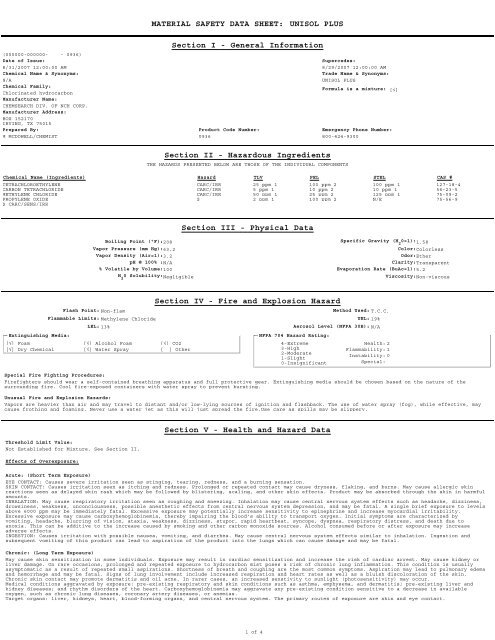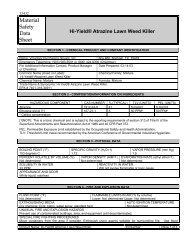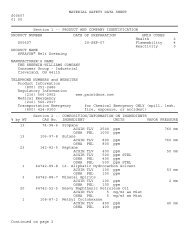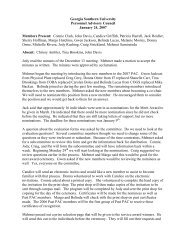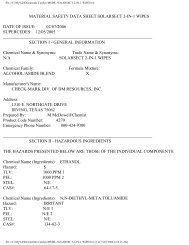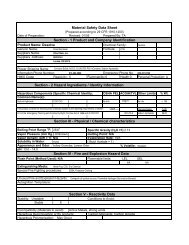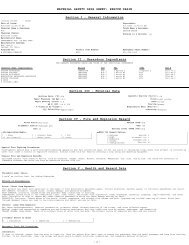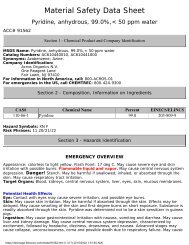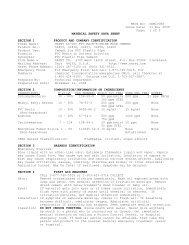MATERIAL SAFETY DATA SHEET: UNISOL PLUS ... - services
MATERIAL SAFETY DATA SHEET: UNISOL PLUS ... - services
MATERIAL SAFETY DATA SHEET: UNISOL PLUS ... - services
Create successful ePaper yourself
Turn your PDF publications into a flip-book with our unique Google optimized e-Paper software.
<strong>MATERIAL</strong> <strong>SAFETY</strong> <strong>DATA</strong> <strong>SHEET</strong>: <strong>UNISOL</strong> <strong>PLUS</strong><br />
(000000-000000- - 0936)<br />
Date of Issue:<br />
8/31/2007 12:00:00 AM<br />
Chemical Name & Synonyms:<br />
N/A<br />
Chemical Family:<br />
Chlorinated hydrocarbon<br />
Manufacturer Name:<br />
CHEMSEARCH DIV. OF NCH CORP.<br />
Manufacturer Address:<br />
BOX 152170<br />
IRVING, TX 75015<br />
Prepared By:<br />
M MCDOWELL/CHEMIST<br />
Section I - General Information<br />
Product Code Number:<br />
0936<br />
Supercedes:<br />
8/29/2007 12:00:00 AM<br />
Trade Name & Synonyms:<br />
<strong>UNISOL</strong> <strong>PLUS</strong><br />
Formula is a mixture: [√]<br />
Emergency Phone Number:<br />
800-424-9300<br />
Section II - Hazardous Ingredients<br />
THE HAZARDS PRESENTED BELOW ARE THOSE OF THE INDIVIDUAL COMPONENTS<br />
Chemical Name (Ingredients) Hazard TLV PEL STEL CAS #<br />
TETRACHLOROETHYLENE CARC/IRR 25 ppm 1 100 ppm 2 100 ppm 1 127-18-4<br />
CARBON TETRACHLORIDE CARC/IRR 5 ppm 1 10 ppm 2 10 ppm 1 56-23-5<br />
METHYLENE CHLORIDE CARC/IRR 50 ppm 1 25 ppm 2 125 ppm 1 75-09-2<br />
PROPYLENE OXIDE $ 2 ppm 1 100 ppm 2 N/E 75-56-9<br />
$ CARC/SENS/IRR<br />
Section III - Physical Data<br />
Boiling Point (°F):208 Specific Gravity (H 2<br />
0=1): 1.58<br />
Vapor Pressure (mm Hg):63.2<br />
Color:Colorless<br />
Vapor Density (Air=1):3.2<br />
Odor:Ether<br />
pH @ 100% :N/A<br />
Clarity:Transparent<br />
% Volatile by Volume:100 Evaporation Rate (BuAc=1):5.2<br />
H 2<br />
0 Solubility: Negligible<br />
Viscosity:Non-viscous<br />
Extinguishing Media:<br />
Flash Point: Non-flam<br />
Section IV - Fire and Explosion Hazard<br />
Method Used: T.C.C.<br />
Flammable Limits: Methylene Chloride UEL: 19%<br />
LEL: 13%<br />
[√] Foam [√] Alcohol Foam [√] CO2<br />
[√] Dry Chemical [√] Water Spray [ ] Other<br />
Aerosol Level (NFPA 30B): N/A<br />
NFPA 704 Hazard Rating:<br />
4-Extreme<br />
3-High<br />
2-Moderate<br />
1-Slight<br />
0-Insignificant<br />
Health: 2<br />
Flammability: 1<br />
Instability: 0<br />
Special:<br />
Special Fire Fighting Procedures:<br />
Firefighters should wear a self-contained breathing apparatus and full protective gear. Extinguishing media should be chosen based on the nature of the<br />
surrounding fire. Cool fire-exposed containers with water spray to prevent bursting.<br />
Unusual Fire and Explosion Hazards:<br />
Vapors are heavier than air and may travel to distant and/or low-lying sources of ignition and flashback. The use of water spray (fog), while effective, may<br />
cause frothing and foaming. Never use a water jet as this will just spread the fire.Use care as spills may be slippery.<br />
Threshold Limit Value:<br />
Not Established for Mixture. See Section II.<br />
Effects of Overexposure:<br />
Section V - Health and Hazard Data<br />
Acute: (Short Term Exposure)<br />
EYE CONTACT: Causes severe irritation seen as stinging, tearing, redness, and a burning sensation.<br />
SKIN CONTACT: Causes irritation seen as itching and redness. Prolonged or repeated contact may cause dryness, flaking, and burns. May cause allergic skin<br />
reactions seen as delayed skin rash which may be followed by blistering, scaling, and other skin effects. Product may be absorbed through the skin in harmful<br />
amounts.<br />
INHALATION: May cause respiratory irritation seen as coughing and sneezing. Inhalation may cause central nervous system effects such as headache, dizziness,<br />
drowsiness, weakness, unconciousness, possible anesthetic effects from central nervous system depression, and may be fatal. A single brief exposure to levels<br />
above 6000 ppm may be immediately fatal. Excessive exposure may potentially increase sensitivity to epinephrine and increase myocardial irritability.<br />
Excessive exposure may cause carboxyhemoglobinemia, thereby impairing the blood's ability to transport oxygen. Initial symptoms are characterized by<br />
vomiting, headache, blurring of vision, ataxia, weakness, dizziness, stupor, rapid heartbeat, syncope, dyspnea, respiratory distress, and death due to<br />
anoxia. This can be additive to the increase caused by smoking and other carbon monoxide sources. Alcohol consumed before or after exposure may increase<br />
adverse effects.<br />
INGESTION: Causes irritation with possible nausea, vomiting, and diarrhea. May cause central nervous system effects similar to inhalation. Ingestion and<br />
subsequent vomiting of this product can lead to aspiration of the product into the lungs which can cause damage and may be fatal.<br />
Chronic: (Long Term Exposure)<br />
May cause skin sensitization in some individuals. Exposure may result in cardiac sensitization and increase the risk of cardiac arrest. May cause kidney or<br />
liver damage. On rare occasions, prolonged and repeated exposure to hydrocarbon mist poses a risk of chronic lung inflammation. This condition is usually<br />
asymptomatic as a result of repeated small aspirations. Shortness of breath and coughing are the most common symptoms. Aspiration may lead to pulmonary edema<br />
and hemorrhage and may be fatal. Signs of lung involvement include increased respiration and heart rates as well as a bluish discoloration of the skin.<br />
Chronic skin contact may promote dermatitis and oil acne. In rarer cases, an increased senstivity to sunlight (photosensitivity) may occur.<br />
Medical conditions aggravated by exposure: pre-existing respiratory and skin conditions such as asthma, emphysema, and dermatitis; pre-existing liver and<br />
kidney diseases; and rhythm disorders of the heart. Carboxyhemoglobinemia may aggravate any pre-existing condition sensitive to a decrease in available<br />
oxygen, such as chronic lung diseases, coronary artery diseases, or anemias.<br />
Target organs: liver, kidneys, heart, blood-forming organs, and central nervous system. The primary routes of exposure are skin and eye contact.<br />
1 of 4
<strong>MATERIAL</strong> <strong>SAFETY</strong> <strong>DATA</strong> <strong>SHEET</strong>: <strong>UNISOL</strong> <strong>PLUS</strong><br />
Primary Routes of Entry<br />
[√] Inhalation [√] Ingestion [√] Absorption<br />
Emergency First Aid Procedures:<br />
Inhalation:<br />
Remove from the area to fresh air. If not breathing, clear the airway and start mouth to mouth artificial respiration. Get immediate medical attention.<br />
Eye Contact:<br />
Immediately rinse the eyes with water. Remove any contact lenses and continue flushing for at least 15 minutes. Hold the eyelids apart to ensure rinsing of<br />
the entire surface of the eyes and lids with water. Get immediate medical attention.<br />
Skin Contact:<br />
Immediately remove contaminated clothing and shoes. Flush affected areas with large amounts of water for 20 to 30 minutes. Get immediate medical attention.<br />
Discard clothing and shoes.<br />
Ingestion:<br />
Give 3 to 4 glasses of water, but DO NOT induce vomiting. If vomiting occurs, give fluids again. Get immediate medical attention. Do not give anything by<br />
mouth to an unconscious or convulsing person.<br />
Notes to Physician:<br />
Chlorinated Hydrocarbons may sensitize the heart to Epinephrine and other circulating catecholamines so that arrhythmias may occur. Careful consideration of<br />
this potential adverse effect should precede administration of epinephrine or other cardiac stimulants and the selection of bronchodilators. Ingestion and<br />
subsequent vomiting of this product can lead to aspiration of the product into the lungs which can cause damage and may be fatal. Depending on the amount<br />
ingested and retained as well as the toxicity of the product, gastric lavage should be considered. Keep patient's head below hips to prevent pulmonary<br />
aspiration. If comatose, a cuffed endotracheal tube will prevent aspiration.<br />
Product Contains Chemicals Listed as Carcinogen or Potential Carcinogen By:<br />
Section VI - Toxicity Information<br />
[√] IARC [√] NTP [√] OSHA [√] ACGIH [√] Other<br />
VOC content: 0.6% by weight; 9.6 g/L<br />
TETRACHLOROETHYLENE<br />
IHL-RAT LC 50 : 34,200 mg/m3/8h 3.<br />
ORL-RAT LD 50 : 2629 mg/kg 3.<br />
SKN-RBT LD 50 : >3228 mg/kg 3.<br />
SKN-RBT SDT: 500 mg/24h mild 3.<br />
EYE-RBT SDT: 500 mg/24h mild 3.<br />
EYE-RBT: severe 4.<br />
ACGIH: A3 - Confirmed animal carcinogen with unknown relevance to humans<br />
IARC group 2A<br />
NTP: Part B. Reasonably anticipated to be human carcinogen.<br />
CARBON TETRACHLORIDE<br />
ORL-RAT LD 50 : 2350 mg/kg 4.<br />
IHL-RAT LC 50 : 8000 ppm 4.<br />
SKN-RAT LD 50 : 5070 mg/kg 4.<br />
ACGIH: A2 - Suspected human carcinogen.<br />
IARC group 2B<br />
NTP: Part B. Reasonably anticipated to be human carcinogen.<br />
METHYLENE CHLORIDE<br />
ORL-HMN LDL o : 357 mg/kg 3.<br />
ORL-RAT LD 50 : 1600 mg/kg 3.<br />
SKN-RBT SDT: 800 mg/24h severe 3.<br />
EYE-RBT SDT: 162 mg moderate 3.<br />
IHL-RAT LC 50 : 52 g/m3 3.<br />
IHL-HMN TCL o : 500 ppm/8h 3.<br />
Tumorigenic data<br />
IHL-RAT TCL o : 3500 PPM/6H/2Y-I 3.<br />
Reproductive data<br />
IHL-RAT TCL o : 4500 ppm/24h/female 1-17 days after conception 3.<br />
Methylene Chloride has been evaluated for possible cancer causing effects in laboratory animals. Inhalation studies at concentrations of 2000 and 4000 ppm<br />
increased the incidence of malignant liver and lung tumors in mice. Three inhalation studies of rats have shown increased incidence of benign mammary gland<br />
tumors in female rats at concentrations of 500 ppm and above and increases in benign mammary gland tumors in males at concentrations of 1500 ppm and above.<br />
Rats exposed to 50 and 200 ppm via inhalation showed no increased incidence of tumors. Mice and rats exposed by ingestion at levels up to 250 mg/kg/day<br />
lifetime and hamsters exposed via inhalation to concentrations up to 3500 ppm lifetime did not show an increased incidence of tumors. 4.<br />
Epidemiology studies of 751 humans chronically exposed to Methylene Chloride in the workplace of which 252 were exposed for a minimum of 20 years did not<br />
demonstrate any increase in deaths caused by cancer or cardiac problems. A second study of 2227 workers confirmed these results. 4.<br />
Laboratory animal studies on mice, rats, and rabbits have been conducted to evaluate the potential reproductive and developmental effects of Methylene<br />
Chloride exposures. Methlyene Chloride exposure has not been shown to cause teratogenic effects (birth defects) in experimental animals. 4.<br />
ACGIH group A3: confirmed animal carcinogen with unknown relevance to humans<br />
IARC group 2B: animal sufficient evidence; human inadequate evidence<br />
NTP: reasonably anticipated to be a human carcinogen<br />
PROPYLENE OXIDE<br />
ORL-RAT LD 50 : 380 mg/kg 4.<br />
IHL-RAT LC 50 : 4000 ppm/4h 4.<br />
SKN-RBT LD 50 : 1500 uL/kg 4.<br />
SKN-RBT SDT: 50 mg/6m severe 4.<br />
EYE-RBT SDT: 20 mg/24h moderate 4.<br />
ACGIH group A3: confirmed animal carcinogen with unknown relevance to humans<br />
IARC group 2B: animal sufficient evidence; human inadequate evidence<br />
NTP: reasonably anticipated to be a human carcinogen<br />
Section VII - Reactivity Data<br />
2 of 4
<strong>MATERIAL</strong> <strong>SAFETY</strong> <strong>DATA</strong> <strong>SHEET</strong>: <strong>UNISOL</strong> <strong>PLUS</strong><br />
Stability<br />
Hazardous Polymerization<br />
[√] Stable<br />
[ ] Unstable<br />
[√] Will not occur<br />
[ ] May occur<br />
Conditions to Avoid:<br />
Direct sunlight and other ultraviolet sources. Avoid heat, hotsurfaces,<br />
sparks, and open flames.<br />
Conditions to Avoid:<br />
N/A<br />
Incompatibility (Materials to Avoid):<br />
Strong oxidizing agents such as Chlorine bleach, Hydrogen Peroxide, Permanganates, and Chromates. Acids and Bases; metals such as Zinc powders, Zinc,<br />
Aluminum powders, Magnesium powders, Potassium, Barium, and Sodium; Amines, Oxygen, water, Methanol, aromatic hydrocarbons, 1,1,1-Trichloroethane. Forms an<br />
explosive mixture with Nitric Acid.<br />
Hazardous Decomposition Products:<br />
Oxides of Carbon, Hydrogen Chloride, Chlorine, Phosgene, May react with freshly galvanized surfaces to produce highly toxic Dichloroacetylene.<br />
Section VIII - Spill Or Leak Procedures<br />
Steps to be Taken if Material is Released or Spilled:<br />
Wear appropriate protective clothing. Eliminate all sources of ignition and ventilate the area. Use only non-sparking equipment. Use care as spills may be<br />
slippery. Shut off source of leak. Dike and contain spill. Absorb with an inert material and transfer all material into a properly labeled container for<br />
disposal. Prevent product from contaminating soil or from entering sewage and drainage systems and bodies of water. Flush area with water.<br />
Waste Disposal Method(s):<br />
Dispose of in accordance with all Federal, state, and local regulations.<br />
Neutralizing Agent:<br />
N/A<br />
Section IX - Special Protection Information<br />
Required Ventilation:<br />
Local ventilation is recommended to control exposure from operations that can generate excessive levels of mists or vapors. Local ventilation is preferred,<br />
because it prevents dispersion into work areas by controlling it at its source.<br />
Respiratory Protection:<br />
Respirators should be selected by and used under the direction of a trained health and safety professional following requirements found in OSHA's respirator<br />
standard (29 CFR 1910.134) and ANSI's standard for respiratory protection (Z88.2-1992). For concentrations above the TLV and/or PEL but less than 10 times<br />
these limits, a NIOSH approved half-facepiece respirator equipped with appropriate chemical cartridges may be used. For concentrations greater than 10 times<br />
the TLV and/or PEL, consult the NIOSH respirator decision logic found in publication No. 87-116 or ANSI Z88.2-1992.<br />
Glove Protection:<br />
Viton or Polyvinyl Alcohol gloves should be worn. Ensure compliance with OSHA's personal protective equipment (PPE) standard for hand protection, 29 CFR<br />
1910.138.<br />
Eye Protection:<br />
Chemical goggles should be worn when handling. Ensure compliance with OSHA's Personal Protective Equipment (PPE) standard for eye and face protection, 29 CFR<br />
1910.133.<br />
Other Protection:<br />
Wear protective clothing when handling. Remove soaked clothing and shoes. A safety shower and an eyewash station should be available. Wash clothing and clean<br />
shoes before re-use.<br />
Section X - Storage and Handling Information<br />
Storage Temperature<br />
Max: 120°F Min: 35°F<br />
Storage Conditions<br />
[√] Indoors [ ] Outdoors [ ] Heated [ ] Refrigerated<br />
Precautions to be Taken in Handling and Storing:<br />
Always store material in its original container. Keep the container tightly closed when not in use. Do not store in aluminum,<br />
aluminum alloys, plastics,or zinc. Use with caution around heat, sparks, pilot lights, static electricity, and open flame. Empty<br />
containers may contain product residues which may exhibit the hazards of the product. To avoid possible explosion, do not<br />
pressurize, cut, weld, solder, drill, grind, or expose empty containers to heat, hot surfaces, sparks, or open flames. Ground and<br />
bond container when handling near flammable vapors and all sources of ignition.<br />
Other Precautions:<br />
Keep out of reach of children. Read the entire label before using the product. Follow the label directions.<br />
Section XI - Regulatory Information<br />
Chemical Name CAS Number Upper % Limit<br />
TETRACHLOROETHYLENE 127-18-4 85<br />
CARBON TETRACHLORIDE 56-23-5 1<br />
METHYLENE CHLORIDE 75-09-2 15<br />
PROPYLENE OXIDE 75-56-9 1<br />
Those Ingredients listed above are subject to the reporting requirements of 313 of Title III of the Superfund Amendments and Reauthorization Act of 1986 and 40<br />
CFR part 372.<br />
Please call 1-800-527-9919 for additional information if you are a California customer. This MSDS is not intended for users in the state of California.<br />
Section XII - References<br />
1. Threshold Limit Values for chemical substances and physical agents and biological exposure indices, ACGIH, 2007.<br />
2. OSHA PEL.<br />
3. Vendor's MSDS.<br />
4. Registry of toxic effects of chemical substances, CCINFOWeb, 2007.<br />
3 of 4
<strong>MATERIAL</strong> <strong>SAFETY</strong> <strong>DATA</strong> <strong>SHEET</strong>: <strong>UNISOL</strong> <strong>PLUS</strong><br />
5. European Chemical Substances Information System (ESIS), International Uniform Chemical Information Database (IUCLID) Chemical Data Sheets.<br />
All the components of this product are in compliance with the Toxic Substances Control Act (TSCA) and are either listed on the TSCA inventory or otherwise<br />
exempted from listing.<br />
---------------------------------------------------------------------------------------------------------------------------------------------------------------<br />
--------------------------------------<br />
IRR: Irritant, OSHA: Occupational Safety & Health Administration, IARC: International Agency for the Research on Cancer, TOX: Toxic, NFPA: National Fire<br />
Protection Association, ppm: Parts Per Million, UEL: Upper Explosion Limit, STEL: Short-term Exposure Limit, SKN: Skin, IHL: Inhalation, COMB: Combustible,<br />
CORR: Corrosive, MUT: Mutagenic, CARC: Carcinogenic, N/A: Not Applicable, TLV: Threshold Limit Value, N/E: Not Established, ORL: Oral, FLAM: Flammable, ASPHYX:<br />
Asphyxiant, C.O.C.: Cleveland Open Cup, PNOR: Particles Not Otherwise Regulated, LEL: Lower Explosion Limit, mg/L: Milligrams per Liter, PNOS: Particles Not<br />
Otherwise Specified, g/L: Grams per Liter, PMCC: Pensky-Martin Closed Cup, NTP: National Toxicology Program, µg/L: Micrograms per Liter, TCC: Tagliabue Closed<br />
Cup, SEV: Severe, RBT: Rabbit, INV: Intravenous, ACGIH: American Conference of Governmental Industrial Hygienists, PEL: Permissible Exposure Limit, MOD:<br />
Moderate, IPT: Intraperitoneal, gm/kg: Grams per Kilogram, C.C.C.: Cleveland Closed Cup, HMN: Human, mg/m3: Milligrams per Cubic Meter, mg/kg: Milligrams per<br />
Kilogram, VOC: Volatile Organic Compound, SDT: Standard Draize Test, MSE: Mouse, GPG: Guinea Pig.<br />
THE INFORMATION CONTAINED HEREIN IS BASED ON <strong>DATA</strong> CONSIDERED ACCURATE IN LIGHT OF CURRENT FORMULATION. HOWEVER, NO WARRANTY IS EXPRESSED OR IMPLIED REGARDING<br />
THE ACCURACY OF THE <strong>DATA</strong> OR THE RESULTS TO BE OBTAINED FROM THE USE THEREOF.<br />
CHEMSEARCH DIV. OF NCH CORP. assumes no responsibility for personal injury or property damage caused by the use, storage, or disposal of the product in a<br />
manner not recommended on the product label. Users assume all risks associated with such unrecommended use, storage, or disposal of the product.<br />
©2008 NCH Corporation All rights reserved.<br />
4 of 4


